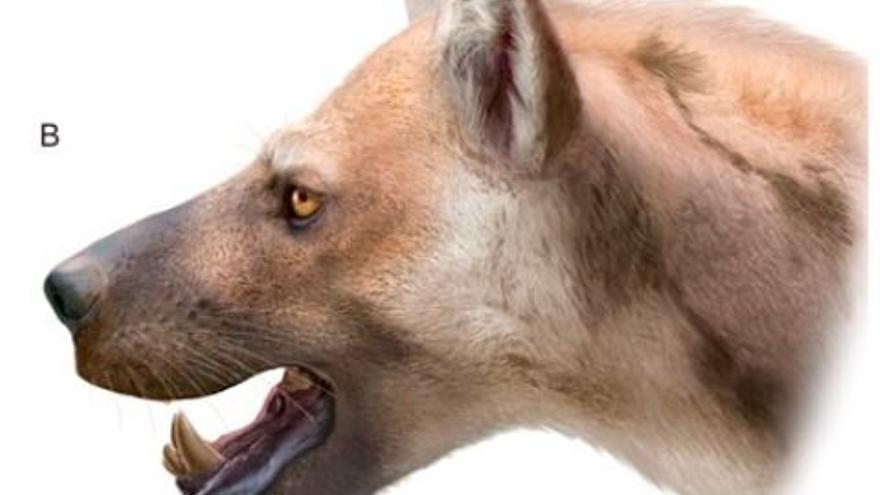They get to know the “bear dog” who lived in Spain

Researchers from several Spanish centers have identified a new species of science that inhabited the peninsula millions of years ago – in the Miocene – a “bear-dog” described from the skull and tooth remains of several specimens found at a site in Madrid.
The research involved scientists from the National Museum of Natural Sciences (MNCN-CSIC), the Instituto Catala de Palacies Miquel Crossfonte (ICP), the University of Alcala (UAH), the University of Zaragoza and the University Research Institute of Environmental Sciences. . de Aragón (IUCA), and the results have been published in the Journal of Systematic Paleontology.
The remains of the new species, baptized as “Ammitocyon kainos” were found at the Batallones 3 site in Madrid between 2008 and 2011, but were initially assigned to another genus (Thaumastocyon).
Subsequent and detailed analyzes of their teeth revealed that they really belong to a new species in science, previously unknown, according to research centers today.
Ammitocyon kainos is distinguished by the length and durability of its chin and muzzle, as well as incisors and canines, which contrast with the absence of the first premolars and last molars, and has highly developed carcass teeth, with large surfaces, sharp and relatively small chewing molars.
These characteristics are considered adaptations of “carnivore hypera,” a condition that occurs when more than 70 percent of an animal’s diet is based on meat, and is not found in any current type of carnivore.
Studies of its bite show that different areas of the jaw perform different functions; While the front part was used to grab prey and tear off large pieces of meat by making sudden lateral movements, the back was used almost like a guillotine, which would chop this meat into smaller pieces.
“His mouth is like a Swiss army knife,” said Juan Abella, an ICP researcher and co-author of the study.
The combination of the properties of the masticatory apparatus and those of the skeleton has not been previously observed and reveals unique environmental adaptations, according to the researchers, who described its front and hind legs as solid and strong, and its very short hands and feet. And its weight may exceed 230 kilos.
“We are in front of a very specialized carnivore,” Abella explained in today’s Research Centers press release, who has determined that due to his anatomical characteristics, he cannot be a very active or agile hunter, like today’s dogs. or felidae, and that it had to hunt by stalking or preying on prey caught by other carnivores.
Ammitocyon kainos lived about 9 million years ago and are the last members of the Thaumastocyoninae family of the amphitoid family, known as the Bear-Dog, although they are not actually the case, according to the researchers. They are closely related to either dogs or bears.
There are no representatives of this family today, but in the past they were one of the most numerous and diverse groups of carnivores in the terrestrial ecosystems of Europe and North America.
“In Battalion 3, it co-existed with other large predators over 150 kilograms, such as Magericyon anceps, the saber-toothed tiger Machairodus aphanistus and the panda relative Indarctos arctoides, so it was his role in the Paleontologist Alberto Valenciano,” explained Alberto Valenciano, a paleontologist. University of Zaragoza and co-author of the study, argue that the ecosystem must be quite specific, in order to be able to support said species in the same area.
The new species’ name, “Ammitocyon kainos” means “Amit’s dog.” Amit was an Egyptian deity with the head of a crocodile and the legs of a lion and a hippopotamus, anatomical features reminiscent of this animal; The researchers explained that the suffix “cyon” means “dog” while “kainos” means “new.”
MNCN researcher Jorge Morales celebrated that after 30 years of excavation, the Cerro de los Batallones sites continue to provide “pleasant surprises”, and emphasized that interest in these sites lies not only in the quality and quantity of fossils found, but also in the verification of new models for the formation of Continental fossil deposits and in the huge potential for biological and geological studies.

“Award-winning zombie scholar. Music practitioner. Food expert. Troublemaker.”


/cloudfront-eu-central-1.images.arcpublishing.com/prisa/AHVYMMDSTZDTDBFNZ3LMFUOKNE.jpg)








